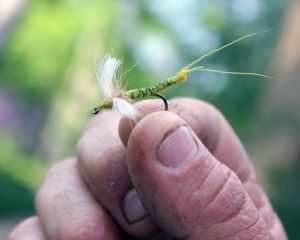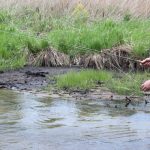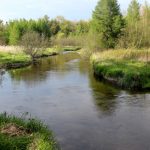On the banks of Tomorrow River
By Greg Seubert
School was in session, but it wasn’t about reading, writing and math.
No, this school was all about trout. And how to catch them.
More than 20 people and instructors showed up May 21 on the banks of the Tomorrow River in Portage County for a crash course in fly fishing. Trout Unlimited’s Frank Hornberg Chapter holds the one-day school each year on the banks of one of Wisconsin’s premier trout streams.
They included Paul Dahlen of New Hope.
“I decided to take this class because my wife bought me a fly rod and I didn’t know how to use it,” he said. “I live new Sunset Lake and I watch all these fish feeding as I drive home from work each night. I thought, ‘Wow, this would be the greatest thing to come here so I know what to do.’”
Instructors were on hand to teach the proper way to cast a fly rod.
Dahlen tried to learn on his own, but soon found out he was in trouble.
“I was doing it all wrong,” he said. “I was not keeping my arm straight on the casting, which really caused me almost to make a whip action. When I did that, the fly was gone and I never saw it again. That was bad because flies cost money. It’s getting the casting right and not being rushed. It seems like you really need to be patient. I would say the hardest thing was learning to be patient and trying to remember the thousand different things that we did learn today.
“We went out into the field here and the instructors walked around and gave individual instruction,” he added. “It looked like everybody was really getting the hang of it. I was actually doing it fairly well at the end. I’m excited to go practice.”
Abe Downs of Plover helped instruct Dahlen and the other students.
“We take someone that hasn’t been on the water and hasn’t cast a fly rod before and increase their knowledge at a faster pace,” said Downs, who also guides for smallmouth and musky from Stevens Point to Rhinelander.
“The hardest part is the casting, getting the fly out to where the fish are,” he said. “That makes everything a lot easier. If you can’t get a fly to where the fish are, you’re not going to catch fish. It takes some practice and skill. A class likes this helps out a lot. Practice in your backyard for 15 or 20 minutes at a crack or go on YouTube and watch casting videos.”
Students also learned how to tie knots and how to read a stream.

“Basically, they need to know how to match the hatch, which means what kind of fly represents what the trout are eating,” Downs said. “Look at what kind of bugs are coming off the water, go into your fly box and pick out what kind of fly matches that bug. You might have hundreds of flies that match different bugs.”
“What size fly, what kind of fly,” Dahlen said. “There are wet flies and dry flies. The staff did a terrific job. I’m really impressed by what they did.”
The Internet has made fly fishing easier to learn, according to Downs.
“It used to be that you had to know someone to teach you how to cast,” he said. “Now, you can look on the Internet and figure out how do it, but it still helps to have someone walk you through it.”
Matt Salchert of Stevens Point has been an instructor at the class for about four years. He is also president of the Hornberg TU chapter.
“For our chapter, it’s to connect people to the river, to really get them involved in learning about the river and learning about the sport of fly fishing,” he said. “Getting people outside more often is really our goal. We can pretty much anybody who has the slightest interest in being outdoors and really give them the information and tools to be a fly fisherperson.”
The Tomorrow River, which starts in Portage County northeast of Stevens Point and flows through Waupaca County as the Waupaca River, is the perfect place to hold such as class. Salchert said.
“The Tomorrow River is a fantastic river,” he said. “It has a good range from being very small and intimate to being a bigger river down toward Waupaca. If you want to fish really small water, you can. If you want to fish big water, you can.
“It has a lot of brown trout in the middle and lower sections,” he said. “The brook trout is kind of the holy grail of trout fishing. It indicates good, clear, well-oxygenated water. If you see a brookie in a stream, that means you’re doing well. When I go out fishing on the Tomorrow, if I catch a brookie, that means I’m doing my job as president of the Hornberg chapter.”
The river also has several public access and easement spots for anglers.
“There are opportunities in the early season, but the opener is really the time when the bugs are really hatching well,” Salchert said. “That starts the mayfly season, where you have a lot of mayfly insects. Opening day also opens up the artificial-only section of the stream, which is a great spot to catch a decent-sized fish.”
“It probably doesn’t have the reputation it once did,” said another instructor, Wyatt Bohm of Amherst. “It can be hit-or-miss. You just have to know when it’s hitting. That makes all the difference in the world.”
“Is the fishing better?” Salchert asked. “That will be debated, but when we go with the DNR crews and do the shocking at the end of the year, the numbers don’t lie. We do have more fish in the stream as a result of the habitat we put in there. When you have problems like the water getting warmer than it should, you need to build structures that can maintain colder temperatures for the fish. Leaving a more narrow channel for that water to go through is going to keep that water cooler. It’s going to ultimately mean we have more fish due to colder water that can hold more oxygen that can produce more fish.”
Bohm is more than happy to share his expertise with other anglers.
“It gives them the confidence that they can get out there on the water and do it themselves,” he said. “It gives them a starting point and a basic idea of what gear does what and which end of the rod to hold. It’s not like your typical fishing, where you can just pick up a rod and go. You need a mentor and that’s what we’re here for. That’s where we all started. We all had a mentor at one time and we’re just passing it down.”
Dahlen wants to use what he learned on the water.
“I’m going to go have some dinner right now, meet one of the instructors and we’re going to go fishing somewhere by Stevens Point,” he said.
He’ll eventually try his luck on Sunset Lake, a small, deep lake northeast of Amherst stocked with rainbow trout. He also plans to be back on the Tomorrow.
“I have kayaks and we’ve actually floated down this river before,” he said. “I’m really excited about bringing my fishing pole and giving it a go.”
Dahlen is also counting on having more success with his new fly rod.
“It’d be like trying to learn any sport without the proper instruction, like going out and playing golf without an instructor,” he said. “It wouldn’t work. You might have glimpses of success, but in terms of really getting the hang of it, I don’t think it could happen.”


